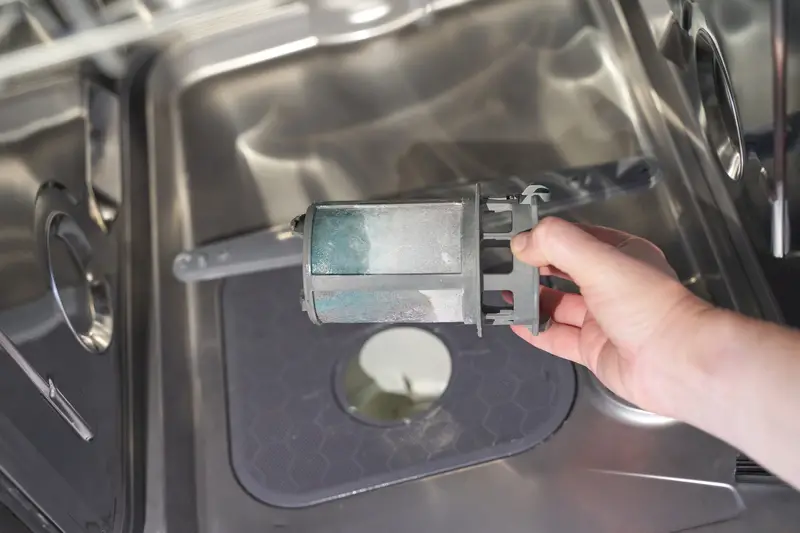Picture this: you open your dishwasher after a full cycle, expecting sparkling clean dishes, only to find food particles still stuck to your plates and a funky smell wafting out. Sound familiar? You’re not alone. According to appliance repair experts, around 70 percent of dishwasher service calls aren’t actually about broken machines – they’re about user error. The good news is that most dishwasher problems can be solved with a few simple changes to how you load and maintain your machine.
Overloading turns your dishwasher into a dirty dish storage unit
That towering stack of plates might look impressive, but it’s the number one reason your dishwasher isn’t doing its job. When dishes are packed too tightly together, water and detergent simply can’t reach all the dirty surfaces. Think of it like trying to wash your car through a fence – the spray just bounces off without actually cleaning anything. This mistake is so common that repair technicians often joke about finding dishwashers loaded like three-dimensional puzzles.
The solution is surprisingly simple: give your dishes some breathing room. Water needs space to circulate freely around each item. Instead of cramming that extra bowl onto an already full rack, wait for the next load. Your dishes will come out cleaner, and you’ll avoid the frustration of having to rewash everything by hand. Plus, proper spacing prevents dishes from chipping against each other during the wash cycle.
Blocking spray arms stops water from reaching your dishes
Those spinning arms at the bottom of your dishwasher aren’t just for show – they’re the workhorses that spray water and detergent onto your dirty dishes. When you place large items like cutting boards or cookie sheets directly over these spray arms, you’re essentially putting a lid on your dishwasher’s cleaning power. The arms can’t rotate properly, and even if they do manage to spin, the water gets blocked before it can reach the rest of your dishes.
Before closing your dishwasher door, take a quick peek to make sure nothing is blocking the spray arms’ path. Large items should go along the sides of the racks, not in the center, where they can interfere with water circulation. If you hear unusual clattering or scraping sounds during a cycle, that’s often a sign that something is bumping against the spray arms. Stop the cycle, rearrange your dishes, and restart for much better results.
Silverware nesting prevents proper cleaning
When all your spoons cuddle up together in the silverware basket, they create little pockets where water can’t penetrate. The same thing happens when you stack similar utensils together – they nest against each other, leaving dirty surfaces untouched by the wash cycle. It’s like trying to wash your hands while wearing gloves; the water never actually reaches the skin that needs cleaning.
Mix things up by alternating spoons, forks, and knives throughout the silverware basket. This prevents nesting and ensures each piece gets properly cleaned. Some people swear by loading handles up for easier unloading, while others prefer handles down for better cleaning of the eating surfaces. The key is to avoid grouping identical utensils together, regardless of which direction you choose.
Using too much detergent creates more problems than it solves
More soap means cleaner dishes, right? Wrong! Adding extra detergent to tackle particularly grimy loads actually backfires in spectacular fashion. Excess soap creates too many bubbles, which interfere with the spray arms’ ability to clean effectively. You’ll end up with streaky, filmy dishes that look worse than when they went in. Plus, leftover detergent residue can build up in your dishwasher’s internal components, leading to clogs and mechanical issues.
Stick to the manufacturer’s recommended amount – usually just enough to fill the detergent dispenser cup. Modern dishwashers are designed to work with specific detergent amounts, and more isn’t better. If your dishes are extremely dirty, it’s better to scrape off excess food and run a longer wash cycle than to dump in extra soap. Also, check the expiration date on your detergent – yes, it can go bad and become less effective over time.
Ignoring your dishwasher’s filter leads to disgusting buildup
That removable filter at the bottom of your dishwasher isn’t just a suggestion – it’s essential for clean dishes. When food particles and grease accumulate in a clogged filter, dirty water starts pooling at the bottom of your machine. Instead of draining away, this grimy water gets sprayed back onto your supposedly clean dishes during the rinse cycle. The result? Dishes that smell funky and have mysterious bits of food stuck to them, even after a full wash.
Check and clean your filter at least once a month, or more often if you run your dishwasher daily. Most filters are easy to remove and can be rinsed under warm water with a soft brush. If you’ve never cleaned your filter before, don’t be surprised if it’s absolutely disgusting – that buildup has been sabotaging your clean dishes for months or even years. Regular filter maintenance prevents that nasty funk and keeps your dishwasher running efficiently.
Pre-rinsing dishes actually makes them dirtier
This one might blow your mind, but thoroughly rinsing your dishes before loading them into the dishwasher can actually result in less clean dishes. Modern dishwashers have sensors that detect how dirty your dishes are and adjust the wash cycle accordingly. When you pre-rinse everything until it’s already clean, the dishwasher thinks it’s dealing with lightly soiled items and runs a gentler cycle that might not remove the remaining grease and residue.
Instead of pre-rinsing, simply scrape off large food particles and load your dishes as-is. Dishwasher detergents contain enzymes that are specifically designed to break down food particles, but they need something to work on. However, don’t go completely crazy and load plates with entire meals still on them – chunks of food can clog your filter and spray arms. The sweet spot is scraped but not rinsed dishes.
Loading plastic items on the bottom rack melts your containers
Nothing ruins your day quite like opening the dishwasher to find your favorite food storage container transformed into modern art. The bottom rack of your dishwasher sits directly above the heating element, which gets extremely hot during the drying cycle. Plastic items placed down there are essentially sitting in a miniature oven, and even “dishwasher-safe” plastics can warp, melt, or develop weird shapes that make them useless for food storage.
Always place plastic items on the top rack, where they’re safely away from the heating element. This simple change will save your containers and prevent melted plastic from potentially damaging your dishwasher. If you’re constantly forgetting which items are plastic, consider adding small dishwasher-safe labels to help everyone in your household load correctly. Your storage containers will last longer, and you won’t have to explain to your family why their lunch containers look like Salvador Dalí paintings.
Putting detergent pods in the wrong spot wastes your money
Tossing a detergent pod into the bottom of your dishwasher might seem logical, but it’s actually a waste of soap and money. Dishwashers are programmed to release detergent at specific times during the wash cycle for maximum effectiveness. When you just throw a pod in the bottom, it dissolves immediately during the pre-rinse phase and gets washed down the drain before the main cleaning cycle even begins. You’re essentially paying for expensive detergent to clean your pipes instead of your dishes.
Place detergent pods in the designated dispenser cup, just like you would with powder or liquid detergent. The timing of detergent release is crucial for proper cleaning, and the dispenser ensures the soap is available during the main wash cycle when it can actually do its job. This simple change will make your dishes cleaner and help your detergent supply last longer, saving you money in the long run.
Neglecting spray arm maintenance reduces cleaning power
Those spinning spray arms don’t just magically stay clean forever – they accumulate food particles, grease, and mineral deposits that can block the tiny holes where water shoots out. When these holes get clogged, water pressure drops dramatically, and your dishes don’t get the forceful spray they need for proper cleaning. You might not notice the buildup at first, but over time, your dishwasher’s performance will gradually decline until you’re wondering why everything comes out still dirty.
Remove and rinse your spray arms monthly to keep them working at full power. Use a toothpick or small brush to clear any stubborn clogs from the spray holes. Most spray arms simply lift out or twist off for easy cleaning, and the whole process takes just a few minutes. While you’re at it, run an empty cycle with a dishwasher cleaning tablet to remove any mineral buildup from the internal components. This simple maintenance routine will keep your dishwasher running like new for years longer.
Your dishwasher is designed to make your life easier, not more frustrating. By avoiding these common mistakes, you’ll get cleaner dishes, extend your appliance’s lifespan, and save money on unnecessary repairs. The best part? Most of these fixes take no extra time – just a small change in how you load and maintain your machine for dramatically better results.

